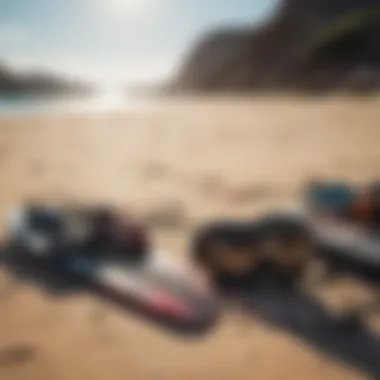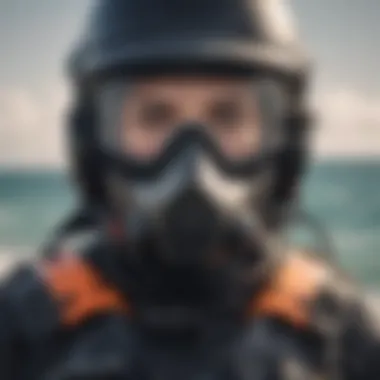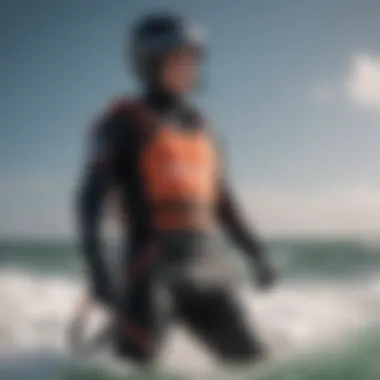Essential Kitesurfing Clothing for Comfort and Safety


Intro
Kitesurfing is more than a sport; it's an adventure that demands precise clothing for optimum performance. What you wear directly affects your comfort, safety, and overall experience on the water. Finding the right kitesurfing attire involves understanding various materials, accessories, and styles that suit different conditions and personal preferences. This guide will help you navigate through the essential clothing requirements for kitesurfing, ensuring you make informed decisions that enhance your performance, regardless of your skill level.
Equipment Reviews
Kites
Kites are central to kitesurfing. The right model can significantly impact your performance. When choosing a kite, consider factors like shape, size, material, and brand.
- Kite Shapes: Common shapes include C-kites and bow kites. C-kites are known for their responsiveness and power, ideal for tricks and jumps, while bow kites offer more stability and depower, suitable for beginners.
- Sizes: The size of the kite affects its performance in different wind conditions. Smaller kites work well in strong winds, whereas larger kites suit lighter winds better.
- Materials: Kites are made from various materials, including ripstop nylon and polyester. Each material offers a unique balance of durability and weight.
- Brands: Popular brands like North Kiteboarding, Cabrinha, and Duotone offer a range of kites catering to different skill levels and styles.
Boards
The choice of board plays a crucial role in how you ride. Look for options that match your style and experience.
- Twintip Boards: These are versatile and great for most conditions. They allow for riding in both directions and are suitable for beginners.
- Directional Boards: Designed for wave riding, these boards are stable and provide better control in surf conditions.
- Construction: Common materials include fiberglass and carbon fiber. Fiberglass boards are more forgiving, while carbon fiber offers more performance.
Accessories
Never overlook the importance of the right accessories. The correct gear enhances your kitesurfing experience.
- Harnesses: A good harness connects you to the kite. Look for options that provide support while allowing for mobility.
- Lines and Pumps: Ensure you have durable lines for controlling your kite and a reliable pump for travel.
- Safety Gear: Helmets and impact vests can minimize injuries in case of accidents.
"Safety should always be a priority when kitesurfing. Investing in good equipment can save your life."
Travel Destinations
Though equipment is critical, knowing where to ride also matters. Popular spots often come with reliable wind and water conditions, while lesser-known destinations can offer unique experiences.
Popular Spots
When planning a kitesurfing trip, some destinations stand out. Places like Cabarete in the Dominican Republic and Maui in Hawaii offer consistent winds and vibrant water sports communities. Consider local amenities like rentals and food options.
Off the Beaten Path
For those seeking adventure, explore lesser-known locations such as Cape Verde or Nicaragua. These spots provide unique challenges and scenery that can enhance your kitesurfing experience beyond the typical tourist routes.
Techniques and Tutorials
Kitesurfing involves more than just gear; mastering techniques is essential.
Beginner Guides
If you're new, focus on learning the basics like launching and balancing on the board. Breaking these skills into manageable steps can help build confidence.
Advanced Skills
Once you are more comfortable, tackle advanced skills such as jumping and wave riding. Practicing these maneuvers can elevate your experience on the water.
Safety Guidelines
Understanding weather patterns and safety measures is crucial in preventing accidents while kitesurfing.
Weather Conditions
Always assess wind and water conditions before kiting. Factors like currents and tides can drastically change, influencing your safety.
Emergency Protocols
It is important to have a rescue plan in place. Familiarizing yourself with common hazards can reduce risks.
Equipment Maintenance
Regular checks of your gear can prevent mishaps. Keep your kites and boards in good condition to ensure safe and enjoyable sessions.
Prolusion to Kitesurfing Clothing
Understanding kitesurfing clothing is pivotal for those who dare to ride the tides and winds. Attire plays a critical role in the overall experience, from ensuring safety to enhancing performance on the water. The right clothing provides weather protection, comfort, and freedom of movement. In other words, it can make or break your session.
The Importance of Proper Attire


Dressing appropriately for kitesurfing is not just about style; it significantly impacts safety and overall enjoyment. Proper attire helps regulate body temperature, protects skin from harsh elements, and reduces the risk of injury. When wind, water, and UV exposure are constant factors, equipping oneself with suitable clothing proves essential.
Additionally, the right gear provides buoyancy and reduces drag. A well-fitted wetsuit, for instance, keeps the body warm in cold waters while offering flexibility.
Therefore, understanding the importance of kitesurfing attire allows riders to focus on performance rather than being distracted by discomfort or hazards. This topic can greatly influence both beginners and seasoned athletes.
Overview of Kitesurfing Gear
Kitesurfing gear is more than just clothing. It encompasses a range of components, each designed with specific functionalities in mind. Broadly, kitesurfing attire includes wetsuits, shorts, harnesses, and accessories. Each piece has a distinct role.
- Wetsuits offer thermal protection and help in buoyancy.
- Shorts and rash guards assist in mobility while also shielding the skin.
- Harnesses allow for better control of the kite and distribute pull evenly across the body.
Incorporating various clothing and gear not only enhances performance but ensures that safety standards are met. Choosing suitable attire should not just be based on preferences but also on the technical requirements of kitesurfing.
This brings us to the next section, where we will discuss how to choose the right kitesurfing attire based on several influencing factors.
Choosing the Right Kitesurfing Attire
Choosing the right kitesurfing attire is crucial in maximizing performance in the water. Numerous elements come into play, from comfort to safety. The correct clothing not only enhances mobility but also provides protection against harsh elements. It allows the kitesurfer to focus on the ride rather than distractions caused by poor fit or inadequate insulation.
When making a choice, consider how material affects both comfort and durability. Kitesurfers face diverse conditions, ranging from warm sun to cold wind and waves. Selecting clothes that can adapt to changing environments makes the activity more enjoyable. Furthermore, proper gear is essential to improve performance on the board.
Factors Influencing Clothing Choice
Various factors influence the selection of kitesurfing clothing. First, the local climate plays a significant role. Warm conditions may warrant lighter options like board shorts and rash guards. On the other hand, cooler weather often demands wetsuits or shorties for adequate thermal protection. Understanding the weather patterns will guide the decision process effectively.
Second, personal preferences also matter. Some kitesurfers prefer tight-fitting garments for less drag. Others may find loose clothing more comfortable. While both choices have merits, personal experimentation is key in finding the right fit.
Lastly, safety considerations cannot be overlooked. High-quality gear can prevent injuries. Features like reinforced seams, padding, and protection from UV rays contribute to overall well-being on the water. Prioritizing safety aids in fostering a positive kitesurfing experience.
Skill Level and Clothing Selection
Skill level significantly interacts with clothing choices for kitesurfers. Beginners may require more protective gear to reduce the risk of injury when learning. This often means opting for a well-fitted wetsuit, which provides warmth and cushioning.
As one progresses, the need for heavy protection may diminish. Advanced riders often prefer less restrictive attire that allows for greater movement. They can choose to wear lighter shorts and rash guards, which enhance performance without hindering agility.
Regardless of experience, it's crucial to select clothing that complements skills. The wrong attire can limit performance. Thus, understanding one’s own abilities helps to decide which gear is most suitable. It ensures that clothing not only protects but also enhances the overall kitesurfing experience.
Types of Kitesurfing Clothing
Understanding the different types of kitesurfing clothing is critical for both performance and comfort on the water. Each category of clothing serves unique purposes, addressing specific conditions that kitesurfers encounter. Selecting the appropriate attire not only enhances the experience but also ensures safety against the elements.
Wetsuits: Functionality and Suitability
Insulation Properties
Wetsuits are essential for providing warmth to the body in cold water. The foam neoprene material traps a thin layer of water between the suit and the skin. This layer is warmed by body heat, offering insulation even in frigid conditions. The effectiveness of insulation is particularly noticeable during prolonged sessions in cold climates, making wetsuits an indispensable part of kitesurfing attire.
Thickness Considerations
Thickness is a vital factor in the selection of wetsuits. Typically, they range from 2mm to 5mm, or more, depending on the water temperature. Thicker suits offer better insulation but may hinder mobility. A 3mm wetsuit often strikes a balance, providing sufficient warmth without excessive bulk. Choosing the right thickness ensures that a kitesurfer remains both warm and agile.
Design Variations
Wetsuits come in various designs such as full suits, spring suits, or shorties. Full suits cover the entire body, providing maximum insulation, which is ideal for colder waters. Shorties keep the arms and legs uncovered, allowing greater flexibility in warmer conditions. Understanding the differences in design helps kitesurfers make informed choices based on the climate they are facing.
Shorties and Rash Guards
Cooling Effects
Shorties are designed to keep kitesurfers cool in warm weather. They are shorter than full wetsuits and made from lighter materials, allowing for better airflow. This aspect is particularly important during summer when water temperatures rise, helping to avoid overheating while riding.
UV Protection
Rash guards provide protection from harmful UV rays due to their special fabric treated for this purpose. As kitesurfing often involves prolonged sun exposure, wearing a rash guard can greatly reduce the risk of sunburn. The importance of UV protection cannot be overstated, as skin health is crucial for long-term enjoyment of the sport.
Mobility Advantages
Both shorties and rash guards allow for optimal mobility. The design minimizes restrictions, enabling fluid movement while kitesurfing. This feature is beneficial for performance as it allows practitioners to maneuver efficiently without feeling weighed down by heavy clothing.
Board Shorts and Swimwear


Materials Used
Board shorts are often made from quick-drying materials like polyester or nylon. This characteristic is essential for kitesurfing, as it helps maintain comfort when transitioning between water and land. The choice of materials also impacts durability against saltwater and sun exposure.
Comfort and Fit
Comfort and fit are key aspects of board shorts. They should allow for unrestricted movement but not be overly loose, which can create drag in the water. Choosing a snug but flexible fit enhances the overall kitesurfing experience.
Style Options
Board shorts come in numerous styles and designs. The variety allows kitesurfers to express personal style while participating in the sport. However, beyond aesthetics, it's crucial to prioritize function over form to ensure that style does not compromise performance.
Harnesses: Types and Features
Waist Harness vs. Seat Harness
Harnesses are essential for attaching the rider to the kite. The primary choice is between waist and seat harnesses. Waist harnesses are more common amongst experienced kitesurfers, as they offer better freedom of movement. Conversely, seat harnesses provide additional support and are often favored by beginners. The choice depends on personal comfort and riding style.
Comfort and Support
The level of comfort and support offered by harnesses is vital for reducing fatigue during kitesurfing. A well-designed harness should distribute pressure evenly across the body. This feature not only enhances comfort but also improves overall control, leading to better performance.
Attachment Points
Harnesses come with different attachment points for the lines. Some harnesses are designed with multiple points which allow for adjustments based on rider preference. This flexibility can greatly enhance comfort and performance when out on the water.
Material Considerations
The choice of materials in kitesurfing clothing significantly affects performance, comfort, and safety. As kitesurfing often demands exposure to varying weather conditions, the right fabrics can enhance the overall experience while minimizing risks associated with the sport. Several specific factors come into play when considering materials for kitesurfing attire.
Breathability and Moisture Management
Effective moisture management is crucial in kitesurfing clothing. When kitesurfers engage in this high-energy activity, sweat accumulates. Suitable materials allow perspiration to escape, keeping the body dry. Materials such as polyester and nylon are often utilized for their breathability and moisture-wicking properties.
Additionally, the incorporation of mesh panels can facilitate airflow, enhancing breathability in high-temperature conditions. Good moisture management not only ensures comfort but also contributes to body temperature regulation, preventing overheating during intense sessions.
Durability and Resistance to Elements
Kitesurfing clothing must be durable to withstand harsh marine environments. The elements, including saltwater, wind, and UV exposure, can deteriorate fabrics over time. Robust materials like cordura and high-denier nylon provide superior resistance to wear and tear. These materials can endure abrasions from contact with the board or other equipment, ensuring longevity of the gear.
Furthermore, items like wetsuits often feature reinforced stitching and additional coatings to increase resistance against moisture and UV rays. This durability is vital for maintaining safety, as compromised gear may lead to issues during kitesurfing.
Environmental Impact of Materials
The environmental implications of material choices in kitesurfing clothing should not be overlooked. Many traditional fabrics and manufacturing processes can have detrimental effects on ecosystems. Increasingly, brands are turning to recycled materials and sustainable production methods to mitigate this impact.
Fabrics made from recycled plastics, such as PET and nylon, are becoming more common. These materials not only help in reducing waste but also perform well in kitesurfing settings. By being mindful of environmental sustainability in material selection, kitesurfers can enjoy their sport while contributing positively to the planet.
"Selecting high-quality materials is not just about performance; it's also about caring for our environment while enjoying our passions."
In summary, understanding the significance of material considerations is central to choosing the right kitesurfing clothing. Factors such as breathability, durability, and environmental impact are essential to ensure a rewarding and safe experience for kitesurfers.
Essential Accessories for Kitesurfing
Kitesurfing offers thrilling experiences, but the right accessories play a crucial role in ensuring safety and comfort. Essential accessories not only enhance performance but also provide protection against varying weather conditions. These items often bridge the gap between just enjoying the sport and doing so with the confidence of adequate support and safety.
Footwear: Choosing the Right Boots
Footwear for kitesurfing is a significant consideration. Proper kitesurfing boots or shoes can protect your feet from rocky surfaces, sharp objects, or cold water. The right footwear should have a good grip to ensure stability while moving around your board.
When selecting kitesurfing boots, consider the following factors:
- Material: Look for boots made from durable and flexible material. Neoprene is popular because it offers insulation and flexibility.
- Fit: A snug fit is crucial to avoid slipping, which could lead to accidents.
- Sole Design: Opt for boots with a non-slip sole for improved grip on the board.
In summary, good footwear is necessary for impact protection and enhances overall performance while kitesurfing.
Headgear: Hats and Helmets
Protecting your head is essential. Headgear can vary from hats designed to shield you from the sun to helmets that offer safety in case of falls. A personal preference may influence your choice, but functionality should never be overlooked.
Consider these elements when choosing headgear:


- Sun Protection: Wide-brimmed hats or caps can help protect your face and neck from harmful UV rays.
- Safety Helmets: A good helmet fits comfortably and stays securely in place. Look for a design that covers the back of your head well.
- Ventilation: If the weather tends to be hot, consider headgear designed with ventilation to prevent overheating.
Using the right headgear offers protection against sun exposure and enhances safety during kitesurfing adventures.
Gloves and Neoprene Accessories
Gloves can significantly increase comfort while kitesurfing. They help to improve grip on the control lines and provide warmth in cooler temperatures. Neoprene gloves are a prevalent choice due to their flexibility and insulation properties.
When selecting gloves and neoprene accessories, keep in mind:
- Fit and Function: Gloves should fit snugly but allow for mobility. This is critical when controlling the kite.
- Thickness: Thicker gloves may provide more warmth but could reduce sensitivity. Choose the thickness based on your local weather conditions.
- Additional Accessories: Consider other neoprene items, such as vests or hoods, for extra warmth and protection if kitesurfing in colder climates.
Weather Considerations
Weather plays a crucial role in the experience of kitesurfing. Each season brings unique challenges and requirements for clothing. Understanding these conditions is vital for safety and enjoyment on the water. Whether facing cold, hot, or rainy weather, kitesurfers must choose appropriate gear to ensure comfort and functionality. Adapting to weather can enhance performance and prevent potential hazards, making informed decisions essential for every session.
Cold Weather Gear
In cold conditions, kitesurfers require specialized clothing to maintain body warmth and protect against hypothermia. Wetsuits made from thicker neoprene are recommended. This material provides insulation to keep the body warm while allowing flexibility. Thickness is a key factor; a 4/3 mm wetsuit is often ideal for colder waters. Also, adding thermal layers under the wetsuit contributes to better insulation.
Accessories like gloves, socks, and beanies are also crucial. These often-overlooked items can help keep extremities warm.
When selecting cold weather gear, consider the following:
- Material Quality: Choose wetsuits with high-quality stitches and seals.
- Fit: A snug fit prevents water from entering the suit. Ensure it is not overly tight, which can restrict movement.
- Ventilation: Look for wetsuits with back zippers or other features to assist in venting when movement increases body heat.
"Choosing the right gear for cold weather is not just about warmth; it's about enhancing your performance and safety on the water."
Hot Weather Gear
In hot weather, the main concern is staying cool while ensuring protection from the sun. Lightweight and breathable fabrics are crucial. Rash guards and shorties are popular choices. They provide UV protection while promoting moisture wicking, keeping the body cool.
When surfing in hot climates, prioritize:
- UV Protection Rating: A shirt with a high UPF rating can be an effective barrier against harmful rays.
- Material Breathability: Look for materials like polyester blends which assist in moisture management.
- Looser Fits: Opt for clothing that allows for air circulation.
Keeping hydrated is also essential. Wearing lightweight hats can shield the face from direct sunlight. A well-ventilated headgear can help with heat management.
Rain and Wind Protection
Kitesurfing often involves dealing with unexpected weather changes, particularly rain and wind. Wind can affect kite control, while rain can significantly reduce visibility and comfort. Proper outerwear is necessary to manage these elements.
Invest in a quality windbreaker or waterproof jacket designed specifically for water sports. This outer layer should be lightweight yet durable. Here are some tips for equipment in rainy or windy conditions:
- Windproof Technology: Look for garments with ripstop fabrics that resist tearing.
- Waterproof Seals: Jackets and pants should have sealed zippers and cuffs to prevent water ingress.
- Packability: Choose options that can be easily packed away when not in use, ensuring convenience.
By considering weather conditions, kitesurfers can select outfits that promote comfort, safety, and performance. Being adequately prepared for different climates transforms the kitesurfing experience.
Maintenance and Care of Kitesurfing Attire
Maintaining and caring for kitesurfing attire is essential for prolonging the lifespan of your gear. Proper maintenance not only enhances performance but also supports safety. Kitesurfing involves exposure to saltwater, sun, and varying weather conditions. Thus, the clothing must withstand tough elements. Effective care will ensure that clothes serve their purpose without compromising functionality.
Washing and Drying Techniques
Washing kitesurfing gear is critical. After each session, rinse off your attire with freshwater to remove salt, sand, and other residues that can degrade fabric. Use a mild detergent designed for technical fabrics. Avoid using bleach or fabric softeners; they can harm the material's integrity.
- Washing in Cold Water: Opt for cold water when washing. It preserves the elastic properties of materials.
- Gentle Cycle: If you use a washing machine, select a gentle cycle to minimize wear.
- Air Drying: Hang or lay flat to dry. Avoid direct sunlight, as prolonged exposure can fade colors and weaken materials.
Storage Best Practices
Where you store your kitesurfing clothes also impacts their durability. Store your attire in a cool, dry place. Avoid damp areas that encourage mold.
- Avoid Folding: Hang your wetsuits and other gear instead of folding. Folding can create creases that weaken the fabric over time.
- Use Breathable Bags: If you need to store items in bags, choose breathable materials to reduce moisture buildup.
- Keep Away from UV Light: Protect your gear from direct sunlight. UV rays can cause materials to break down.
By following these maintenance and care guidelines, kitesurfers can ensure their attire remains in optimal condition, providing comfort and safety on the water.
Epilogue
In this article, we explored various aspects of kitesurfing clothing and how it impacts performance and safety. The right attire is more than just personal preference; it is essential for the comfort and protection of the kitesurfer. Proper clothing choices mitigate risks, such as hypothermia in cold water and sunburn in warm conditions. This is especially crucial while kitesurfing, where exposure to water and wind can rapidly change body temperature.
Key Takeaways
- Proper Attire is Crucial: The garments you choose can protect against the elements and enhance performance during kitesurfing.
- Different Conditions Require Different Gear: Always consider weather patterns and body temperature when selecting clothing. What works on a sunny day may not be suitable in cooler conditions.
- Material Matters: Look for fabrics that provide not only durability but also functionality, like moisture-wicking properties and resistance to wear.
- Accessories Can Enhance Safety: Gear such as wetsuit boots, gloves, and headgear is vital for comfort and protection.
- Maintenance Extends Lifespan: Proper care, including washing and storing outfits correctly, helps retain clothing quality over time.
Final Thoughts on Kitesurfing Clothing Choices
Choosing the right kitesurfing clothing is not just about style; it’s a matter of safety and performance. Each choice, from wetsuits to accessories, plays a role in how effectively you can navigate the wind and waves. Additionally, being informed about materials and weather considerations empowers kitesurfers to make decisions that suit their personal preferences and conditions.
"The right clothing elevates the kitesurfing experience by addressing comfort and safety needs."







